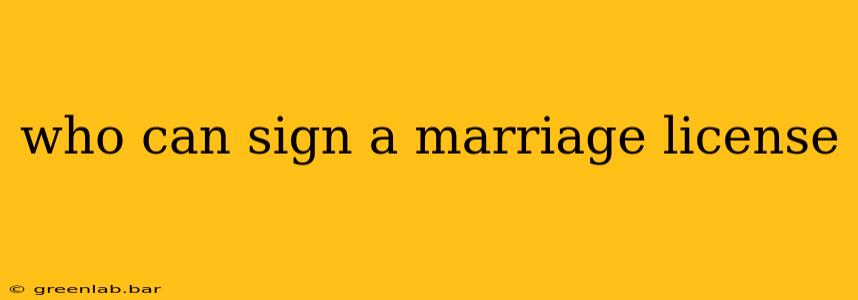Getting married is a significant milestone, and understanding the legal requirements is crucial. One key aspect is knowing who is authorized to sign your marriage license. The specifics vary slightly depending on your location (state or country), but this guide will provide a general overview and highlight key differences. This information is for guidance only; always confirm the specific requirements with your local county clerk's office or equivalent authority.
Authorized Officiants: The Key Players
The most common individuals authorized to sign a marriage license are officiants. These are individuals legally empowered to perform marriage ceremonies and officially witness the union. The specific types of officiants vary by jurisdiction, but generally include:
1. Judges and Court Officials:
Many jurisdictions allow judges, justices of the peace, and other court officials to officiate weddings and sign marriage licenses. These individuals hold significant legal authority and are commonly recognized throughout the country.
2. Clergy Members:
Ministers, priests, rabbis, imams, and other clergy members are often authorized to officiate marriages within their respective religious traditions. The specific requirements for authorization can vary depending on the religious organization.
3. Public Officials:
Depending on the state or country, certain public officials beyond the court system might be authorized. This could include mayors, county clerks (in some cases), or other designated government employees. Always check your local regulations.
4. Designated Individuals:
Some states and countries allow for individuals to be designated or commissioned as officiants. This often requires completing specific training or filing applications with the relevant authorities. This route might be particularly relevant for wedding planners or other professionals who regularly perform ceremonies.
Variations Across Jurisdictions: Understanding the Nuances
While the above categories represent common authorized signatories, it's essential to acknowledge the variations between jurisdictions:
- State-Specific Laws: Marriage license requirements vary significantly from state to state in the United States. Some states have stricter rules regarding who can officiate, while others have more relaxed regulations. Always check your state's specific laws on their government website.
- International Differences: Outside the U.S., the regulations concerning who can sign a marriage license can vary even more drastically. Some countries have highly centralized systems, while others have more decentralized processes. Research the specific requirements of the country where the marriage will take place.
Consequences of Unauthorized Officiants:
It's crucial to ensure that the person signing your marriage license is legally authorized. A marriage performed by an unauthorized individual may be considered invalid, leading to potential legal complications down the line, such as issues with:
- Spousal benefits: Health insurance, taxes, inheritance rights, and other benefits associated with marriage may be jeopardized.
- Legal recognition: The marriage might not be legally recognized in the eyes of the law, affecting legal documentation and official records.
- Divorce proceedings: Complications could arise during a divorce proceeding if the marriage was not legally valid.
Verifying the Officiant's Credentials:
Before your wedding, always verify the officiant's credentials. Contact your local county clerk's office or the relevant authority to confirm their authorization to perform marriages. This simple step can save you significant time, money, and potential legal problems in the future. Don't hesitate to ask for proof of their credentials, ensuring a legally sound and stress-free marriage.
This article aims to provide a general understanding of who can sign a marriage license. Always confirm the specific regulations with your local authorities to ensure a legally binding and recognized marriage. Remember, accurate information is key to a smooth and successful wedding process.

